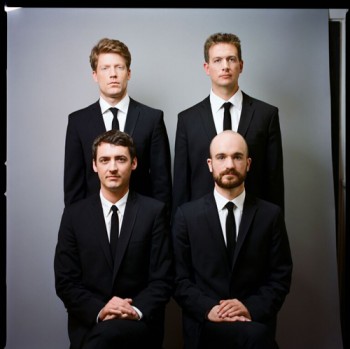by Timothy Robson

The program was intellectually stimulating as well, as one would expect from this brainy quartet (violinists Benjamin Jacobson and Andrew Bulbrook, violist Jonathan Moerschel, and cellist Eric Byers), who with this concert completed a two-year, four-concert residency at the museum. There were just two works totalling about an hour’s duration, with no intermission: Swedish composer Anders Hillborg’s Kongsgaard Variations (2006) and Ludwig van Beethoven’s String Quartet No. 14 in c-sharp, Op. 131.
Hillborg’s variations are based upon the Arietta theme of Beethoven’s last piano sonata, but it is not until the end of the piece that the theme is fully revealed. For most of the work’s 15-minute duration, the theme is deconstructed and presented in bits and pieces, often virtually unrecognizable. The writing is mostly tonal, often lush and lyrical with hints of Scandinavian folk fiddling style. Musical textures range from thick and rich to sparse and delicate. At times, sharp, slicing, accented dissonances are interspersed with long-held chords. At others, Hillborg employs a kind of “metrical modulation,” using consecutively slower note values to give the impression of elongating the tempo. Finally, Beethoven’s theme is heard, but in a new harmonization. It doesn’t last long before vanishing in a cloud of shimmering glissandi and trills, the variations completed.
Throughout the work the Calder Quartet played with brilliant technical virtuosity and precision of detail and balance. In such a small venue it was illuminating to observe the players communicating with each other by means of a glance or raised eyebrow.
Beethoven’s String Quartet No. 14 in c-sharp, Op. 131 might be the ultimate string quartet experience, with its seven continuous movements and forty-minute duration. It is as challenging to listen to as it is to perform, a work in which Beethoven explored the depths of human intellectual drama. It is one of the composer’s late quartets, and although it is identified (and published as) No. 14, it was actually the 15th to be composed, in 1826. The work is emotionally dark and harmonically adventurous. In some ways it seems almost as contemporary as the Hillborg variations that opened the concert.
The piece opens with a mournful fugue in c-sharp, but with numerous chromatic excursions. A dance-like movement in triple meter follows, and a brief recitative leads into the set of variations that form the heart of the quartet. After a Presto in E-major, another brief transitional section leads to a closing Allegro in C-sharp minor, with jagged rhythms and a lyrical secondary theme. In the end, C-sharp major wins over the minor key.
The Calder Quartet gave an unrelentingly somber reading of the quartet. Even the E-major Scherzo was darkly colored, pressing on with the drama. Only at the end was there an apotheosis that finally wrenched the tonality into a bright major key. For almost two hundred years, performers and scholars have debated the meaning of this quartet. The Calder Quartet’s interpretation may not be the last word, but it was a convincing — and exhausting — performance of a timeless masterpiece.
Published on ClevelandClassical.com April 4, 2016.
Click here for a printable copy of this article



